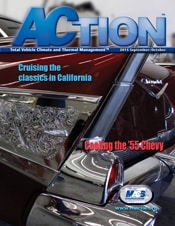Do you know how to cool a classic car?
Few have a better right to address “Cooling the Classics” than MACS Technical Advisor Ward Atkinson, who was the test and development engineer for the first production A/C system introduced on the 1955 Chevrolet.
The demand for passenger comfort in hot weather prompted many crude attempts at cooling. One story is that people traveling in the southern parts of the United States on hot days in the 1920’s reportedly purchased ice cold water melons and held them in their laps to keep cool. Another attempt included the building of ice-boxes in vehicles and circulation of air through the boxes to cool the passenger compartment. This approach was short-lived, however, because from these early experiments engineers determined that, with ambient temperatures approaching 40°C (100°F), it took at least 90.8 kg (200 pounds) of ice per hour to cool a five-passenger sedan. The heat exchanger (heater or evaporator) transfers enough heat at full capacity to change 90.8 kg (200 pounds) of ice to water per hour. At that rate, a six-hour trip would require 544.8 kg (1,200 pounds) of ice for air conditioning purposes. Download the September-October 2015 issue of award winning ACTION magazine.

